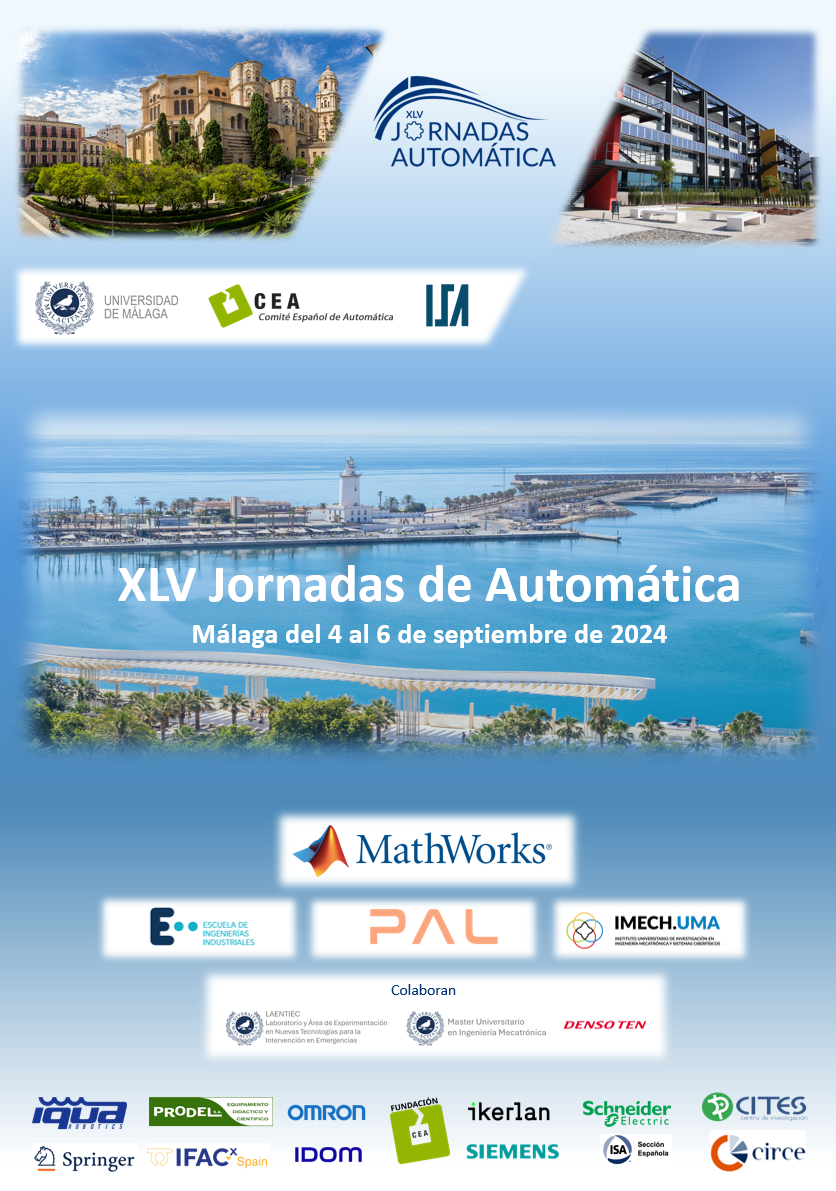Rehabilitación médica mediante Robótica (CDPR) y Realidad Virtual
Proyecto VirtualR3
DOI:
https://doi.org/10.17979/ja-cea.2024.45.10812Palabras clave:
Ingeniería de Rehabilitación y Asistencia Sanitaria, Instrumentos Virtuales, Sistemas de Control de Movimiento, Sistemas Mecatrónicos, Tecnología RobóticaResumen
El artículo presenta la investigación que se está realizando en el marco del proyecto europeo VirtualR3 "Virtual Reality in Robotic movements assistance for Rehabilitation". El objetivo es el desarrollo de un prototipo para realizar ejercicios de rehabilitación de miembros inferiores para pacientes con distintos grados de necesidades terapéuticas mediante robótica paralela CDPR junto con Realidad Virtual. El artículo presenta este el marco de investigación del proyecto y se centra en la integración entre el control de movimiento del CDPR y el seguimiento de los movimientos por parte del dispositivo de Realidad Virtual que llevará el paciente (gafas). Se analizan las prestaciones de la integración entre el CDPR como maestro del movimiento y la RV en seguimiento, y el alternativo del dispositivo de RV como maestro y CDPR en seguimiento, que serán empleadas en los distintos modos de funcionamiento del sistema.
Referencias
Barbazza, L., Oscari, F., Minto, S., Rosati, G., 2017. Trajectory planning of a suspended cable driven parallel robot with reconfigurable end effector. Robotics and Computer-Integrated Manufacturing 48, 1–11. DOI: 10.1016/j.rcim.2017.02.001
Belda-Lois, J.-M., Mena-del Horno, S., Bermejo-Bosch, I., Moreno, J.C., Pons, J.L., Farina, D., Iosa, M., Molinari, M., Tamburella, F., Ramos, A., Caria, A., Solis-Escalante, T., Brunner, C., Rea, M., 2011. Rehabilitation of gait after stroke: a review towards a top-down approach. J NeuroEngineering Rehabil 8, 66. DOI:10.1186/1743-0003-8-66
Brull, A., Zubizarreta, A., Cabanes, I., Rodriguez-Larrad, A., 2020. Sensorized tip for monitoring people with multiple sclerosis that require assistive devices for walking. Sensors 20, 4329. DOI: 10.3390/s20154329.
Carricato, M., Merlet, J.-P., 2013. Stability Analysis of Underconstrained Cable-Driven Parallel Robots. IEEE Trans. Robot. 29, 288–296. DOI:10.1109/TRO.2012.2217795
Clavel, R., 1989. Device for displacing and positioning an element in space. US4976582A.
Delgado-Oleas, G., Romero-Sorozabal, P., Lora-Millan, J., Gutierrez, A., Rocon, E., 2023. Bioinspired Hierarchical Electronic Architecture for Robotic Locomotion Assistance: Application in Exoskeletons. IEEE Access 11, 131610–131622. DOI:10.1109/ACCESS.2023.3336003
Deutsch, J.E., Myslinski, M.J., Kafri, M., Ranky, R., Sivak, M., Mavroidis, C., Lewis, J.A., 2013. Feasibility of Virtual Reality Augmented Cycling for Health Promotion of People Poststroke. Journal of Neurologic Physical Therapy 37, 118–124. DOI:10.1097/NPT.0b013e3182a0a078
Díaz, I., Gil, J.J., Sánchez, E., 2011. Lower-Limb Robotic Rehabilitation: Literature Review and Challenges. Journal of Robotics 2011, 1–11. DOI:10.1155/2011/759764
Hamzeheinejad, N., Roth, D., Monty, S., Breuer, J., Rodenberg, A., Latoschik, M.E., 2021. The Impact of Implicit and Explicit Feedback on Performance and Experience during VR-Supported Motor Rehabilitation, in: 2021 IEEE Virtual Reality and 3D User Interfaces (VR). IEEE, Lisboa, Portugal, pp. 382–391. DOI:10.1109/VR50410.2021.00061
Hesse, S., Uhlenbrock, D., Werner, C., Bardeleben, A., 2000. A mechanized gait trainer for restoring gait in nonambulatory subjects. Archives of Physical Medicine and Rehabilitation 81, 1158–1161. DOI:10.1053/apmr.2000.6280
Huamanchahua, D., Tadeo-Gabriel, A., Chavez-Raraz, R., Serrano-Guzman, K., 2021. Parallel Robots in Rehabilitation and Assistance: A Systematic Review, in: 2021 IEEE 12th Annual Ubiquitous Computing, Electronics & Mobile Communication Conference (UEMCON). IEEE, New York, NY, USA, pp. 0692–0698. DOI:10.1109/UEMCON53757.2021.9666501
Landsberger, S.E., 1984. Design and construction of a cable-controlled, parallel link manipulator (PhD Thesis). Massachusetts Institute of Technology.
Li, Y., Huang, J., Tian, F., Wang, H.-A., Dai, G.-Z., 2019. Gesture interaction in virtual reality. Virtual Reality & Intelligent Hardware 1, 84–112. DOI:10.3724/SP.J.2096-5796.2018.0006
Luque-Moreno, C., Ferragut-Garcías, A., Rodríguez-Blanco, C., Heredia-Rizo, A.M., Oliva-Pascual-Vaca, J., Kiper, P., Oliva-Pascual-Vaca, Á., 2015. A Decade of Progress Using Virtual Reality for Poststroke Lower Extremity Rehabilitation: Systematic Review of the Intervention Methods. BioMed Research International 2015, 1–7. DOI:10.1155/2015/342529
Putranto, J.S., Heriyanto, J., Kenny, Achmad, S., Kurniawan, A., 2023. Implementation of virtual reality technology for sports education and training: Systematic literature review. Procedia Computer Science 216, 293–300. DOI:10.1016/j.procs.2022.12.139
Qian, S., Zi, B., Shang, W.-W., Xu, Q.-S., 2018. A Review on Cable-driven Parallel Robots. Chin. J. Mech. Eng. 31, 66. DOI:10.1186/s10033-018-0267-9
Surdilovic, D., Bernhardt, R., 2004. STRING-MAN: a new wire robot for gait rehabilitation, in: IEEE International Conference on Robotics and Automation, 2004. Proceedings. ICRA ’04. 2004. IEEE, New Orleans, LA, USA, pp. 2031-2036 Vol.2. DOI:10.1109/ROBOT.2004.1308122
Zhang, P., Zhang, J., Elsabbagh, A., 2023. Fuzzy radial-based impedance controller design for lower limb exoskeleton robot. Robotica 41, 326–345. DOI:10.1017/S0263574722001333
Zhang, Z., Shao, Z., You, Z., Tang, X., Zi, B., Yang, G., Gosselin, C., Caro, S., 2022. State-of-the-art on theories and applications of cable-driven parallel robots. Front. Mech. Eng. 17, 37. DOI:10.1007/s11465-022-0693-3
Descargas
Publicado
Número
Sección
Licencia
Derechos de autor 2024 Garrido, J., Riveiro, E., Silva-Muñiz, D., do Olmo-Otero, D.

Esta obra está bajo una licencia internacional Creative Commons Atribución-NoComercial-CompartirIgual 4.0.





